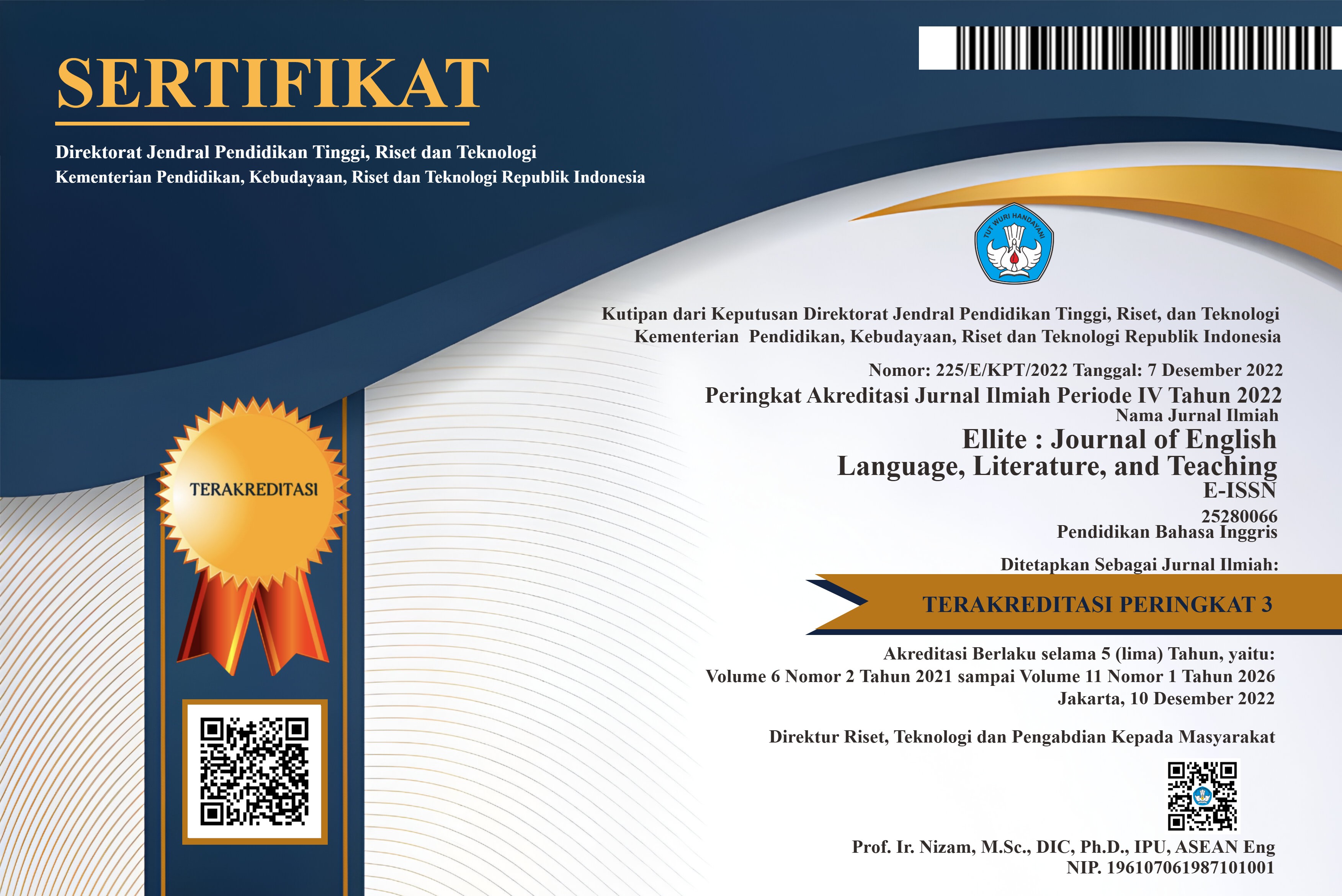Let's Read Application in the View of Recreational Readers
DOI:
https://doi.org/10.32528/ellite.v10i1.3561Keywords:
Digital Literacy, Let’s Read Application, Recreational Reading, Student ExperiencesAbstract
This research investigates the use of the Let's Read application from the perspective of recreational readers, focusing on students from the English study program at UIN Datokarama Palu. The study aims to understand how students define recreational reading, explore their experiences using the application, and identify encountered challenges. Employing a qualitative case study design, the research gathered data through document reviews and semi-structured interviews with five purposively selected participants. Data analysis followed thematic coding framework guided by Miles and Huberman's qualitative data analysis model. Findings revealed that students possess clear conceptual understanding of recreational reading as leisure activity distinct from academic obligations. The Let's Read application was appreciated for its accessibility, offline reading features, and culturally relevant content. Participants reported increased reading frequency and strengthened identity as recreational readers. However, challenges included limited content targeting older readers, technical issues such as unstable connections, and search limitations within the application. The study concludes that while Let's Read significantly supports recreational reading, enhancements in content diversity and user experience are needed to better serve older student readers. The research offers insights for developers, educators, and policymakers seeking to promote digital literacy and reading engagement through mobile applications.
References
Amy Rogan, 2022. Why is recreational reading important. Pulse Media: https://pulse.findlay.edu/2022/opinion/why-is-recreational-reading.important/.
A, Rofi'i., Siska, W., Yunus, N., Purnama, Y., & Sholihah, H. I. A. (2024). INFORMATION AND COMMUNICATION TECHNOLOGY (ICT) INTEGRATION IN THE TEACHING OF ENGLISH: A SYSTEMATIC REVIEW. International Journal of Teaching and Learning, 2(3), 782-794.
A, Stevani. M., Ambarini, R., & Setyorini, A. (2023). Enhancing Students' Reading Comprehension Using Let’s Read Application In Visualization Strategy. CENDEKIA: Jurnal Ilmu Sosial, Bahasa dan Pendidikan, 3(4), 01-08.
Ben Ghida, D., & Ben Ghida, S. (2024, April). Rethinking higher education post-COVID-19: Innovative design studio teaching to architecture students. In AIP Conference Proceedings (Vol. 2799, No. 1). AIP Publishing
B. Finley, E. Boz, K. Kilkki, J. Manner, A. Oulasvirta, H. Hämmäinen (2017). Does network quality matter? A field study of mobile user satisfaction, Pervasive and Mobile Computing. 39 80-99. https://doi.org/10.1016/j.pmcj.2016.08.014.
B, Flyvbjerg. (2006). Making organization research matter: Power, values, and phronesis. The Sage Handbook of Organization Studies, 2nd edition, Thousand Oaks, CA, Sage, 370-387.
Billington J. (2015). Reading Between the Lines: the Benefits of Reading for Pleasure.
Cho, K. S., & Krashen, S. (2019). Pleasure reading in a foreign language and competence in speaking, listening, reading and writing. TEFLIN journal, 30(2), 231-236.
Clark, C., & Rumbold, K. (2006). Reading for Pleasure: A Research Overview. National Literacy Trust.
Cremin, T. (2014). Reading for pleasure and reader engagement: Reviewing the research. In Building communities of engaged readers (pp. 5-19). Routledge.
Fuaziati, Endang., (2013). “PROS_Endang Fauziati_English as a Global Language_fulltext.Pdf,”
Ghalebandi, S. G., & Noorhidawati, A. (2019). Engaging children with pleasure reading: The e-reading experience. Journal of Educational Computing Research, 56(8), 1213-1237.
Graddol, David. “Why Global English May Mean the End of ‘English as a Foreign Language,” English Next 53, no. 9 (2013).
H, Li. (2024). Harnessing emotional design strategies to manage excessive use of short video platforms among young adults: A mobile application design demonstratio
I, Levin., & Mamlok, D. (2021). Culture and society in the digital age. Information, 12(2), 68.
I, Mardiah Junaidi, M., Hadi, M. J., & Aulia, A. (2022). The Effectiveness of Using Let’s Read Application As a Media to Improve Student English Vocabulary In Junior High School. LINGUISTICS AND ENGLISH LANGUAGE TEACHING STUDIES (LAELTS), 3(2).
Levine, Shelby L., et al. "For the love of reading: Recreational reading reduces psychological distress in college students and autonomous motivation is the key." Journal of American College Health 70.1 (2022): 158-164.
K, Haynes (2012). Reflexivity in qualitative research. Qualitative organizational research: Core methods and current challenges, 26, 72-89.
Krashen, S. 2004. The Power of Reading. Portsmouth, NH: Heinemann, and Westport, CONN: Libraries Unlimited (second edition).
Krashen, S. 2011a. Free Voluntary Reading. Westport: Libraries Unlimited.
Makdis, N. (2020). Penggunaan e-book pada era digital. Al-Maktabah, 19, 77–81. UIN Imam Bonjol Padang.
Nandy. (2025). Kapan waktu yang tepat untuk membaca buku? Gramedia Literasi. Acssessed on 25 April 2025. https://www.gramedia.com/literasi/waktu-yang-tepat-untuk-membaca/.
Novita, D., Hamied, F. A., & Sukyadi, D. (2023). The Effect of Culturally Familiar Text on Low-Proficiency Reader’s Reading Comprehension. NOBEL: Journal of Literature and Language Teaching, 14(1), 115-132.
Hakim, M. F. Al, & Azis, A. (2021). Peran Guru dan Orang Tua: Tantangan dan Solusi dalam Pembelajaran Daring pada Masa Pandemic COVID-19. Riwayat: Educational Journal of History and Humanities, Vo. 4(1), 16-25.
Retelsdorf, J., Köller, O., & Möller, J. (2014). Reading achievement and reading self-concept – Testing the reciprocal effects model. Learning and Instruction, 29, 21–30. 10.1016/j.learninstruc.2013.07.004.
Shelby L., et al. "For the love of reading: Recreational reading reduces psychological distress in college students and autonomous motivation is the key." Journal of American College Health 70.1 (2022): 158-164.
Prof.Dr.Sugiyono, Metodologi Penelitian Kualitatif. In Metodologi Penelitian Kualitatif, Rake Sarasin, 2020.
Pratiwi Sari, N. N. (2024). THE IMPLEMENTATION OF LET’S READ APPLICATION TOWARD STUDENTS’LITERACY (Doctoral dissertation, Universitas Pendidikan Ganesha).
Putri, D., & Savitri, W. E. (2022). The Use of Digital Book Let’s Read Application in Improving Reading Comprehension For Junior High School Student. Yavana Bhasha: Journal of English Language Education, 5(2), 106-117.
Rizky, Khalifatussalam. (2021). Low Literacy in Indonesia: Understanding and Factors That Influence It. https://www.researchgate.net/publication/356021876_Low_Literacy_in_Indonesia_Understanding_and_Factors_That_Influence_It.
Schwabe, A., Kosch, L., Boomgaarden, H. G., & Stocker, G. (2023). Book readers in the digital age: Reading practices and media technologies. Mobile Media & Communication, 11(3), 367–390. https://doi.org/10.1177/20501579221122208
Thadani, N. 2022. The Benefits of Recreational Reading. Mason Grad Insider, George Mason University. March 8, 2022.
The Consumer Technology Association (CTA) Research, 2024. Exploring Gen Z Views and Preferences in Technology. https://www.cta.tech/Resources/Newsroom/Media-Releases/2024/February/CTA-Research-Exploring-Gen-Z-Views-and-Preferences.
Twenge, J. M. (2024). Are books dead? Why Gen Z doesn't read. Generation Tech. https://www.jeantwenge.com
UNESCO (2020), Indonesia Case Study https://www.unicef.org/eap/media/9326/file/sit%20an%20%20indonesia%20case%20study.pdf.
Valensia Sopian (2024), Pengaruh Social Influence Terhadap Minat Menggunakan Media Sosial Melalui Sikap Generasi Z di Kota Palembang. Socius: Jurnal Penelitian Ilmu-Ilmu Sosial. 12 (1), 581-587. 3025-6704. https://doi.org/10.5281/zenodo.13144366
Wilhelm, J. D. (2016). Recognising the power of pleasure: What engaged adolescent readers get from their free-choice reading, and how teachers can leverage this for all. The Australian journal of language and literacy, 39(1), 30-41.
W, John Creswell and J. David Creswell, Research Design: Qualitative, Quantitative, and Mixed Methods Applicationes (Sage publications, 2017).
Downloads
Published
Issue
Section
Categories
License
Copyright (c) 2025 suud mujizatullah, Ruslin, Dzakiah

This work is licensed under a Creative Commons Attribution 4.0 International License.







